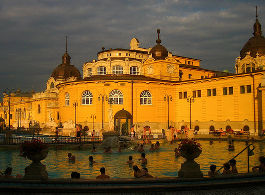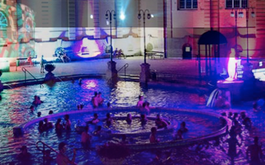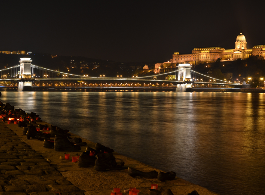Current Public Holidays in Hungary & The Mandatory Communist April 4
As you are coming to Budapest, it is good to know which days are the public holidays in Hungary. Most shops (even in shopping malls), banks, restaurants, etc. are closed and public transportation is less frequent (instead of 2-5 minutes you may have to wait 10-20 minutes for buses, trolleys, trams etc. – however, the metro/ underground is still very frequent coming every 5 minutes or so). Most of the public holidays are celebrated by outdoor events, public concerts and shows, contests, excursions, picnics, if weather allows, alongside official national celebrations.
Here’s the complete list of the Hungarian public holidays:
- 1st January (New Year)
- 15th March (commemorating the 1848/49 revolution and war of independence against the Austrian rule)
- Easter Sunday and Monday
- 1st May (Labour Day)
- Whit Sunday and Monday
- 20th August (threefold celebration: the celebration of Bread, the name day of Saint Stephen, the first king of Hungary, and the foundation of the Hungarian state)
- 23rd October (anniversary of the 1956 revolution and war of independence)
- 1st November (All Saints’ Day): most people go to the cemetery, and there’s a handful of Halloween parties (Halloween is relatively freshly imported – similarly to Valentine’s day).
- 25-26th December (Christmas) Watch out for Dec 24! not an official public holiday yet but most of the shops, restaurants, bars, theatres etc. close on this day. Families celebrate together in the evening.
Some History
During communism in Hungary (up until 1989 when the democratic transition took place), the list of the public holidays was slightly different – most notably October 23rd was not celebrated (1956 was called ‘anti-revolution’), while March 21, April 4 and November 7 were. April 4 was the most powerful and most colorful reddest holiday. April 4 1945 was the day when the Soviet soldiers defeated the Nazi troops, and also the very same day that – retrospectively – meant the beginning of totalitarianism for most Hungarians. The day is not exactly the last day of World War II for Hungarians, and most people simply said that ‘the Russians came in in 1945′ which referred to the two-edged move later on (liberation and occupation). But not in 1945 necessarily as many people in 1945 assumed that the Soviet soldiers (who stayed in Hungary until 1991), would go home after the peace pact (1947). Not so.
Also, people were celebrating differently: many of them were forced to celebrate of course. Forced to put on a broad smile and believe the lies that Hungarian economy was thriving, Hungarian factories were outdoing any western factories, Hungarian pigs were always giving the highest number of piglets possible, etc. etc. Even if people were forced with direct physical contact, they were under the constant mental pressure of potentially being spied on through the effective spying system, where you had to watch your neighbour and your friends (!) – all potential spies for the communist government. You did not have to hold an important position to be monitored. But descendants of former Hungarian aristocracy, religious people, writers, poets, artists were especially under control. Maybe your friends were just spies in order to survive or protect their families, if they were threatened by communists (and oftentimes they were). But maybe they believed in the system or were simply brutally unscrupulous survivors.
Due to the general mandatory celebrating spirit, the vast majority of Hungarians was staying with the officially celebrating crowds. All schools – without exception – even kindergartens were happily celebrating the end of WW2 and the beginning of soviet Hungary: Soviet inspired poems, songs were performed, red balloons, little red flags and Hungarian flags made of paper and wooden stick were waved by the smallest children and the biggest adults. Kids were marching in scout-like groups (senior high school kids, so called pioneers were wearing red-scarves, junior high school kids, so called ‘little drummers’ were wearing blue scarves to their blue and white uniforms), and the TV showed the best moments of the parades. Everyone smiling, happy, full of soviet power and energy to transform the world into – prosperity?
I must add though that as a kid (aged 3-12) I was pretty much enjoying the parades, the big choirs, the competitions, the whole event – and had no clue what was behind these false happy celebrations, why adults were whispering strange things, why they are laughing at political humorist Géza Hofi, why some of the teenagers and young people burnt their red scarves as a sign of rebel, etc.. So I am from a generation that got relatively the best & most humorous part of communism, the weakening tail of it, and then suddenly grew up in a young chaotic democratic Hungary from 1989.
Here’s a slideshow of Hungarian pioneers with the most typical upbeat pioneer song entitled Mint a mókus fenn a fán. It was The Greatest Hit, so to say, with an easy lyrics: Like the squirrel on the tree, Pioneers are so happy, they do not stop singing for a moment. If they strike a camp somewhere, they will start to sing as well, and they don’t stop singing for a moment, etc. etc.
These days? No, you won’t see huge masses of hundreds of thousands of people. Many people either stay at home and watch TV, or tend to the garden, go to the parks and the free concerts taking place, climb hills and relax with friends, drink a beer or two, or three, etc. But at this moment as I am writing these lines, I feel that it may not be true for the next couple of years – at least taking into account some recent Hungarian political events and the reactions of several interest groups.
Warning
October 23 (commemorating 1956) is particularly touchy – marked by the conflicts between the two major parties (Hungarian Socialists and the Young Democrats – the former party thought of by several Hungarians as the legacy of the communist era, while the latter party thought of by several critics as overtly nationalistic.). So if you should be staying in Budapest during October 23, I suggest avoiding the major scenes of national celebration (there is no blood shedding, or major physical dangers, but you may be pushed around with the crowd, or just feel uncomfortable to see quarrelling and shouting people).
source (in Hungarian) for the fictitious April 4 1945 date from Domonkos Szőke historian on Nol.hu








